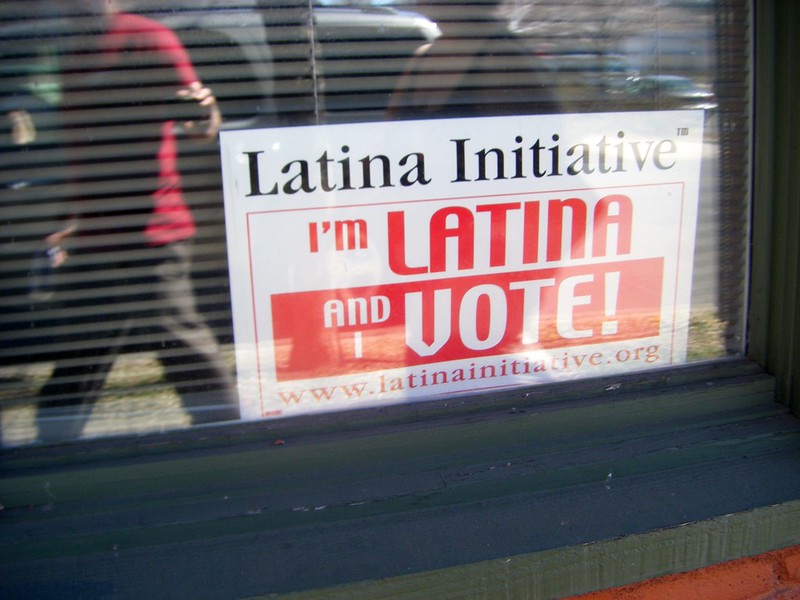Over half of the total U.S. population growth since 2010 was caused by an increase in the Latino population. Expanding Latina political power is no longer a strategy for the future—it’s happening now.

Latinas have been active in politics for more than 100 years as suffragists, civil and women’s rights organizers and candidates for local, state and federal government. Over the past decade, we’ve witnessed the fruits of their labor flourish into a rise in Latinas’ political power.
And now, the Hispanic population is becoming a major political force in America: According to the 2020 census, over half of the total U.S. population growth since 2010 was caused by an increase in the Latino population, which now accounts for 18.7 percent of the country. For the first time, the number of white Americans has fallen below 60 percent—meaning the U.S. is steadily becoming more diverse, and voters of color will continue to grow in political importance.
Additionally, more Latinas are running for office than ever before, and they are imprinting the national and local landscapes with their tildes, diverse cultural identities and policy ideas centered on social justice issues such as gender equity, workers’ rights and economic opportunity. For instance, in 2020, we saw a record number of Latinas running for Congress. They’ve broken barriers and transformed the way elections are run and won. But, most importantly, they’ve discarded archaic political playbooks and replaced them with the authenticity of their life stories—and throwing away the rule book seems to be working and resonating with voters.
In June, we witnessed this political metamorphosis in New York’s local primary election. Latina candidates running for city council in districts spanning the Bronx and Queens swept one victory after another, setting up a November general election poised to change the City Council’s demographics. Latinas are also running for prominent statewide positions in 2021 and 2022, with several leading historic races that might yield the first Latinas elected to their seats.
Beyond expanding their presence in politics, Latina candidates are transforming the archetype campaign playbook—many elect to advocate for policies to solve the same problems they encountered throughout their lives. When Ileana Ros-Lehtinen became the first Latina elected to Congress in 1989, she established a path for the next generation of Latina elected officials and leaders.
Since then, governments across the country have sworn in an increasing number of leaders like Delegate Hala Ayala, candidate for Virginia lieutenant governor. Ayala was a single mother who worked at a gas station and went on to become one of the first Latinas elected to the Virginia General Assembly, the oldest legislative body in the country.
Tonite, I had a chance to speak to @HalaAyala and congratulate her for making history. At @latinovictoryus we are proud of our contribution to such a historic moment. https://t.co/p5WQ1yk4sH
— Luis A. Miranda, Jr. (@Vegalteno) June 9, 2021
By leading campaigns focused on their life stories and their authentic selves, Latina candidates are finding innovative ways to connect with their voters, especially voters of color who until recently began seeing themselves represented in their government. They’re also lifting the veil on the Latino community’s vast diversity, depicting what we mean when we say, “Latinos are not a monolith.” The Latina leaders who have made history and their successors who are running for office are a microcosm of the Latino experience.
Always appreciate the opportunity to be in community discussing critical issues, including Latino representation, the economy, and voting rights with @POTUS and @VP.
— Nathalie Rayes (@NathalieRayes) August 3, 2021
Together, we will create a more just & inclusive democracy. https://t.co/rz1tkhz9Sd
This is not happening only in states with sizable Latino populations like Florida, Texas and California—and it didn’t begin in 2021. Latinas have been running for office since Nina Otero-Warren ran for Congress in 1922. Each wave of women’s and civil rights movements solidified their status as leaders and agents of change.
There’s no doubt that the political earthquake that was the 2016 election sparked a dormant ember that awakened to fire up Latinas to run for office against the threat of misogynistic forces bent on rolling back hard-fought women’s rights. That wave of Latina enthusiasm elected the first Latina U.S. senator, the first Latina mayor of Tucson and the first two Latinas elected to represent Texas in Congress, among countless other local, state and federal ‘firsts.’
None of these victories and changes occured by chance, for Latinas have learned to fight for every seat and think creatively to win over voters who are not used to seeing names like theirs on the ballot. In the 2020 election, Latinas organized like never before and turned out to vote. As we look toward 2022, 2024 and beyond, we can only expect Latinas to continue building up their political power, increasing their representation in government, and breaking barriers. The first Afro-Latina elected to Congress or the first Latina elected mayor of New York might just be making headlines soon.
However, there’s no need to wait for the future to see Latinas blazing pathways in politics. We only have to look at the most recent elections to see that Latinas who are leading with intention and flipping the rulebook are upending the political landscape. Expanding Latina political power is no longer a strategy for the future—it’s happening now.
Up next:





